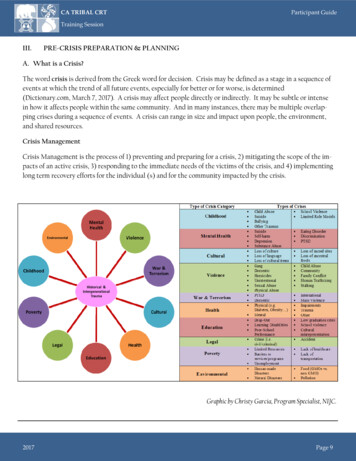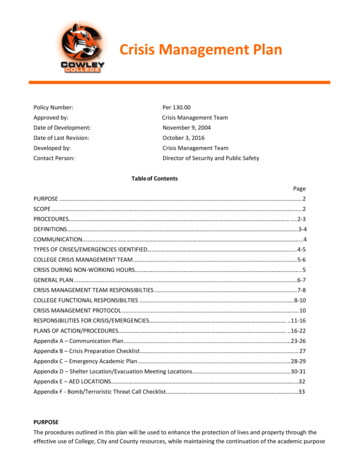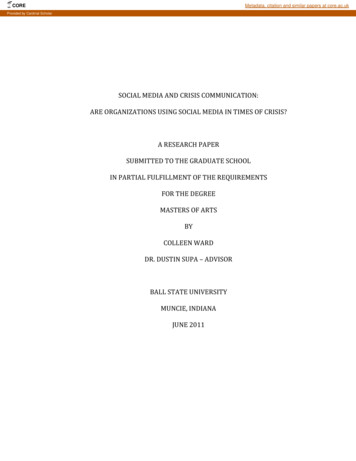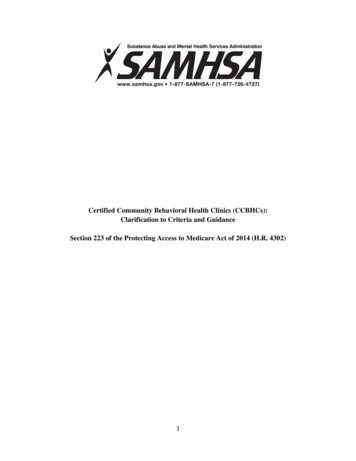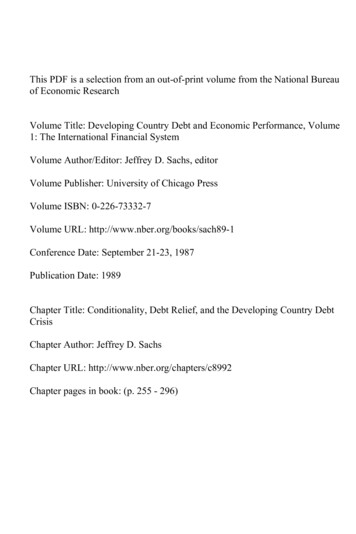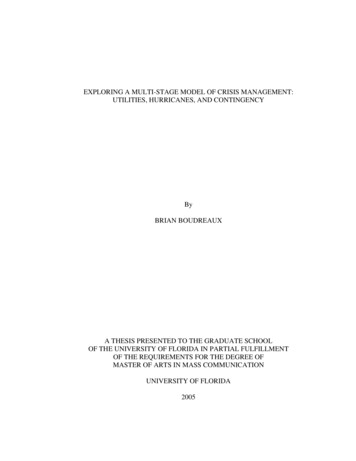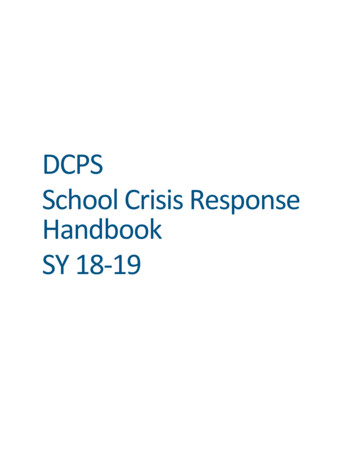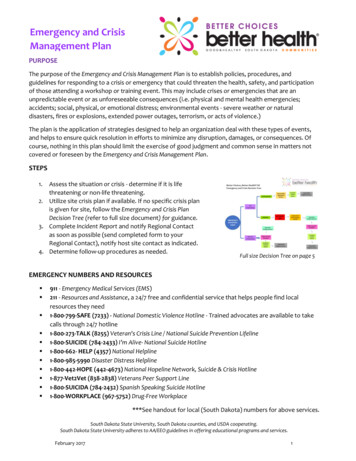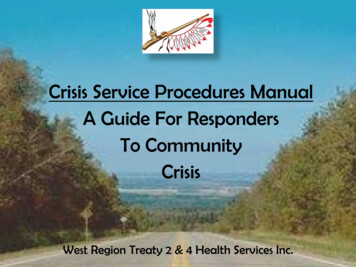
Transcription
D CURBAN LIFEFast growing citiesneed eco-friendlytransport optionsDEVELOPMENT ANDCOOPERATIONENTWICKLUNG UNDZUSAMMENARBEITD CE ZInternationalJournalMONTHLY E-PAPERPOPULIST POLITICSWhy many Brazilianshave lost faith indemocracyISSN2366-7257February 2019HANDICRAFTSA Bengali traditionnow serves toempower womenGlobal environmentin crisis
D C February 2019In German in E ZEntwicklung und Zusammenarbeit.Both language versionsat www.DandC.euTitle: Gold mines contribute to the destruction of the Brazilian Amazon.Photo: Raimundo Valentim/picture-alliance/(EPA) EFEFOCUSGlobal environment in crisisMonitorLocal communities matterSustainable transport Paul Collier’s new book on the future of capitalism Nowadays: Fighting fake news in Indonesia Imprint 4DebateComments on south-south cooperation, the government of Ecuardor’s shift to theright and the financial scandal rocking Benin 8TribuneCARLOS ALBUQUERQUEWhy Brazil’s democracy is in deep crisis 11INTERVIEW WITH JOACHIM NAGELKfW board member discusses the scope of development finance 13ADITI ROY GHATAKTraditional handicrafts are changing lives of many Bengali women for the better 15Focus: Global environment in crisisCARMEN JOSSEIndigenous peoples are key stakeholders in protecting Amazonian forests 18FATIMA ARKINUN platform appreciates indispensible traditional knowledge 19KERSTIN OPFERServing the enviroment and improving rural livelihoods in Morocco 21KARIM OKANLAWhy deforestation is progressing fast around Savè, a small town in Benin 22CAROLYN WILLIAMS-GERDESFlawed urban planning resulted in a devastating landslide in Sierra Leone’s capital 24INTERVIEW WITH ANITHA REDDYSouth Indian farmers benefit from cultivating regional landraces 26JENNY KRUTSCHINNASaving coral reefs will require action beyond climate protection 29STEPHAN OPITZKfW draws lessons from 30 years of conservation finance 30INTERVIEW WITH DIRK MESSNERMost destructive environmental trends are mutually reinforcing 32AVIVA FREUDMANNWorld Bank assesses global flood of garbage 34D C e-Paper February 2019 Humanity cannot afford to lose the Amazonianforests, but deforestation is progressing. Recognised indigenous territories serve as protectivebarriers, reports Carmen Josse of the FundaciónEcoCiencia in Ecuador. In Morocco, the HighAtlas Foundation is running a pro-poor agroforestry programme that improves people’s livelihoods as well as the health of the natural environment. The key to success is the participatoryapproach, writes Kerstin Opfer, who evaluated theprogramme. Media scholar Karim Okanla assesseswhy grassroots communities are driving deforestation around Savè in rural Benin. Carolyn Williams-Gerdes took part in a UNDP mission after adevastating landslide in Freetown in Sierra Leonein 2017. One lesson, she argues, is that urban planning must take into account multi-faceted environmental issues. PAGES 18, 21, 22, 24Protecting biodiversityHigh-tech farming erodes the biodiversity of agriculture. Organic agriculture with traditional landraces is a sustainable alternative. It is promotedby Sahaja Samrudha, a non-governmental farmersorganisation in India, as Anitha Reddy, Samrudha’s communications director, elaborates. Tropical coral reefs are often likened to rainforests dueto their great biodiversity. In spite of their incalculable value to humanity, they are under threat,warns Jenny Krutschinna of Reef Check, an NGO.Stephan Opitz of KfW Development Bank drawslessons from 30 years of conservation finance. PAGES 26, 29, 30“The most powerful driving force isclimate change”The earth system is changing dramatically withimpacts on the environment and people’s lives.Dirk Messner, the director of the Institute forEnvironment and Human Security of the UnitedNations University (UN-EHS), explains the greatest risks – and what kind of global transformations are needed to manage them. PAGE 32Awash in trashThe world is drowning in garbage. According to arecent World Bank study, under current trends theworld will generate 3.4 billion tonnes of municipalsolid waste per year by 2050, up from 2.0 billiontonnes in 2016. Journalist Aviva Freudmann summarises the study. PAGE 34
OUR VIEW(SW-Thema)DebateUndeniable challengesYou’ll find all contributions of our focus sectionKATJA DOMBROWSKIplus related ones onis member of the editorial team of D Cour website – they’ll beDevelopment and Cooperation / E Zcompiled in next month’sEntwicklung und Zusammenarbeit.briefing section.euz.editor@fazit-communication.deD C e-Paper February 2019 Anger about lurch to the rightLenín Moreno was elected president of Ecuador inMay 2017 as the candidate of the Alianza País (AP),a centre-left party. He seemed to defy the continental trend to more right-wing politics. The wayhe is running the country fits that pattern, however, disappointing his supporters. Timm Benjamin Schützhofer, a scholar, assesses the situation. PAGE 9TribuneValuable traditionPhotos: picture-alliance/NurPhoto; Abdul Malek Babul/LineairRecently, I went to see a freshly prepared whale skeleton with my family. Theyoung sperm whale had belonged to a group of about 30 bulls who had accidentally entered the North Sea three years ago and never found their way out.The University of Gießen obtained one of the carcasses and has now put theskeleton on public display.Why the whales went astray on their way south from the Arctic Oceanis unknown. One theory is that they followed swarms of the octopuses theyfeed on. The squids normally find the North Sea too cold, but they may haveended up there either because of increasing water temperatures or unusualcurrents that resulted from strong storms. Another theory is that underwaternoise from ships and oil rigs disoriented the whales. Solar flares, which influenced the earth’s magnetic field, are yet another possible reason why theylost their way. Whether the whales fell victim to human-made change in theirenvironment is not certain.In any case, however, a stranded whale perfectly illustrates the fragilityof ecosystems – and it triggers emotions. As large mammals, whales resembleus. My children were impressed because the bones of a sperm whale’s pectoralfin look very much like those of a human hand.Whales appeal to humans, and so do polar bears or orang-utans, twoother endangered species that activists like to use as symbols for environmental protection. Pictures of such animals feature prominently in campaigns toprotect the climate or primeval forests for example. Using photos this way isentirely legitimate – but the survival of individual species is not what matters most. For the earth system, it is probably irrelevant whether the spermwhale, the polar bear or the orang-utan goes extinct. What is most relevant,by contrast, is that species have never disappeared in such great numbers andat such great speed as they do today. The great risk is that entire ecosystemswill collapse should “tipping points” be reached and irreversibly change theenvironment.No doubt, humans are the driving force behind the major environmentalchanges we are witnessing. The dangerous trends are being accelerated by ushumans as we overexploit resources, produce waste and generate emissions.Our entire economic system is destructive – especially in the industrialisedcountries. The great challenge, therefore, is to change that system. For goodreason, the UN has been tackling the issues for many years. In 1992, at theEarth Summit in Rio de Janeiro, the international community agreed on theparadigm of sustainable development, adopting important agreements suchas the Framework Convention on Climate Change, the Convention on Biological Diversity, the Forest Principles and the UN Convention to Combat Desertification. Many other agreements have since been concluded, such as theAgenda 2030, which includes the Sustainable Development Goals (SDGs), andthe Paris Agreement on climate change in 2015. What is still lacking, of course,is determined implementation.We must not give up. In September, the UN will hold the next sustainability summit in New York, four years after the previous one. It must add strongmomentum to fulfilling the commitments made in international agreements.Kantha is a traditional handicraft in the Indianstate of Westbengal and Bangladesh. On bothsides of the border, women are generatingincomes by stiching and selling intricate embroideries, as Kolkata-based business journalist AditiRoy Ghatak reports. PAGE 15The marathon of development financeLast year, Joachim Nagel joined the board of theKfW Group. He is in charge of its internationalbusinesses, including the division for global development. In an interview, he discussed the principles of sustainability and the financing needs toimplement the SDG agenda with D C/E Z’sSabine Balk and Hans Dembowski. PAGE 13
MONITOR: CONFERENCES AND STUDIESPUBLIC TRANSPORTRethinking mobilityMobility in the cities of emerging marketsand developing countries is becoming evermore important. While countries of the globalnorth aim to reduce car traffic and make itcleaner, many countries of the global southare facing completely different challenges.There is usually neither mass car traffic yet,nor do they have good public transport systems. Experts promote sustainable solutions.By Sabine BalkIn industrialised countries, the aspiration isto expand and improve public transport sopeople stop commuting by car. E-mobility isa hot topic. Emission-free cars or buses withelectric motors are being favoured. To curbcongestion, people are encouraged to sharethe use of cars, organised by companiessuch as Uber or Zipcar.The global south is facing rather different challenges, says Shreya Gadepalli ofthe Institute for Transportation and Development Policy (ITDP), a global non-governmental organisation focusing on planningand building sustainable transportationsystems. The most widely used means oftransport in India, for example, are “feet andbicycles”. The reason is not that Indians areenvironmentally aware. They simply lackalternatives. According to Gadepalli, thereis hardly any public transport in India: onlytwo percent of trips are made by metro, ninepercent by train and 18 % by bus. Informalmeans such as private minibuses or rickshaws, by contrast, are very important.Gadepalli vehemently opposes expanding car traffic. It is environmentallyharmful and unsustainable. “We need tobuild roads for walking,” she declares. In heropinion, intelligent traffic concepts must bedeveloped, and they should mainly rely onextensive bus networks. At the DevelopmentFinance Forum (DFF), which KfW Development Bank hosted in Frankfurt at the end ofDecember, she called for bus transport to besubsidised.ITDP has already achieved a lot, Gadepalli says. For example, it has advised themunicipal authorities in the Indian cities ofPune and Chennai. Ten years ago there wereno sidewalks. ITDP made it clear that sidewalks improve road safety, and some 100kilometres of sidewalks have been built.Matthew Baldwin, mobility expert ofthe European Commission, points out thatemerging markets and developing countriesshould not follow the northern example. “Inthe past, when we were poorer, we used towalk or cycle,” he says. “As we got richer, webought cars.” Now the question is how to getCities in developingcountries andemerging marketsneed new mobilitysolutions: traffic inPhoto: sbNew Delhi.D C e-Paper February 2019 4
MONITOR: CONFERENCES AND STUDIESaway from cars again in the global north.The global south should not start to rely onthem in the first place.Gadepalli has a solution: making driving expensive and bus transport cheap, preferably free of charge. In the end, money isalways the decisive factor.The World Resources Institute (WRI),a think tank based in the USA, is working on concepts for what urban mobilityshould look like all over the world in thefuture. WRI’s Aniruddha Dasgupta is convinced that a turnaround in mobility isneeded to keep cities liveable. In Frankfurt,he stated: Mobility is not an end in itself, accessibility and connections matter just as much.Traffic planning must be “inclusive”. Roadusers should have links to every means oftransport. For example, sidewalks and cyclepaths should lead to bus and train stations.Moreover, park-and-ride spaces should beavailable. Bus and train lines should be coordinated. Mass transport must not be forgotten.Where passenger numbers are large, lightrail systems should be built. Funding is crucial, so governments, development banksand private companies must join forces andrise to the challenges together (see box below). A good example is metro constructionin Nagpur, India, which KfW is supportingwith a promotional loan (see my essay inTribune section, D C/E Z e-Paper 2019/01). Data are becoming ever more abundant and relevant. They must be regarded asinfrastructure. Data processing can revealmobility needs and identify traffic flows inways that allow for organising and optimising.Fifty metro lines per yearThe need for transport infrastructure in developing countries and emerging markets ishuge. Without engagement ofthe private sector, this needcannot be met. One reasonis that governments lack themoney, another is that privatecompanies have indispensable expertise and experience.They want investments to besafe, however, so private-publicpartnerships (PPPs) can be a solution.In Asia alone, up to 100billion are needed annually forpublic transport infrastructure,according to James Leather ofthe Asian Development Bank(ADB). Some 50 metro linesmust be built each year to meetthe needs of ever more citydwellers, he estimates: “Theneed for private-sector investment is huge.” One positiveexample he mentioned at theKfW’s Development FinanceForum in Frankfurt in December is Bangkok. The Thai capitalused PPPs to build mass transittrains and toll roads. “The government would not have doneit alone,” Leather says.Latin America needsmore and better transport infrastructure too. “In Brazil, wehave to more than double it,”says Anie Amicci of the Brazilian development bank BNDES.Private-sectorcontributionsare essential, she says, but admits that “the environmentfor investing is difficult”. Thetram in Rio de Janeiro (seeKfW supplement in D C/E Zprint issue 2018/09-10) is a bestpractice PPP. Nonetheless, it isdifficult to replicate, becausethe private sector wants moreguarantees than municipalauthorities offer so far. She seesbig challenges that the government must rise to. In hereyes, an appropriate regulatoryframework is needed: “We areestablishing transport authorities, at the national and metropolitan level, that have a goodDasgupta criticises the fact that mostdata, such as Google Maps, is owned byprivate-sector companies. Since it is of greatpublic relevance, it should be in the publicdomain. These data are requested by municipal authorities and also by institutionssuch as the World Bank, GIZ or KfW.One goal is, for example, to supportinformal bus operators in setting up a formal company. An interesting example ofhow data can be used for improvement isWhereIsMyTransport. The US companycaptures routes, schedules and types of informal data in African and Latin Americancities.Dasgupta advocates creativity in theface of changing demand and sees the prospects for new mobility as positive: “Technological change is possible – even in a veryshort time”.overview of the system.” Theywill have their work cut out forthem, as informal transportneeds to be formalised. More over, a coherent system of fareprices is needed for all modesof transport. Another issues isthat “the urban mobility sectorneeds subsidies, because fareswill never cover the costs inBrazil.”ReinhardFitzworksfor Doppelmayr, an Austriancable-car constructor, whichbuilt local-transport infrastructure in Bolivia’s capital La Pazand other agglomerations inmountain areas. In his eyes, “astrong partnership” is key forinvestors. “We need reliablecooperation; the governmentshould be involved from the beginning,” he says. His companywants warrants that subsidieswill flow should revenues dropbelow a certain level. On theother hand, the partners fromthe public and private sectorsshould share revenues if theytop a certain level. He alsopoints out that the pre-projectphases are costly and wantsstate agencies to invest in fea-sibility studies and related matters.His view is not commonly shared in Latin America, as Paloma Ruiz of theLatin American developmentbank Corporación Andina deFomento (CAF) reports: “Urban transport is not seen asa public service.” Therefore,subsidies are the exception inLatin America. Ruiz calls fora change of mind: “The car isnot the queen anymore”, and“improving transportation ispart of improving the qualityof life”. In Lima, for instance,where there is almost no masstransport, the middle and upper classes are increasinglyforced to use bicycles, she says,because congestion is terribleand bikes are faster than cars.Ruiz demands to improve theconditions for pedestrians.Moreover, she calls for metrolines and BRT (bus rapid transit) systems (see NicholasHollmann in D C/E Z e-Paper2016/10, focus section) in bigcities. “It is a big developmentchallenge,” she concludes.Katja DombrowskiD C e-Paper February 2019 5
ECONOMIC DOCTRINESMutual obligationsPaul Collier’s new book “The future of capitalism” is a response to the twin shocks ofthe Brexit referendum and Donald Trump’selection in 2016. The Oxford economistassesses why masses of voters felt disenfranchised and what can be done to improvesocial inclusion.By Hans DembowskiThe economist states that his professionmust bear some of the blame for the riseof right-wing populists. Collier argues thatmarket-radical doctrines, which gainedtraction in the past four decades, have distorted social reality. It is plainly not true thatthe public good results from every individual acting in a spirit of radical selfishness.must also provide staff with a sense of purpose, and take into account the needs andinterests of various stakeholders. Legislation should force it to do so. By contrast,market-orthodox policies have widened social disparities.According to the scholar, economistsowe the public three “mea culpas” for having promoted overly simplified policies: While it is correct that internationaltrade increases the aggregate prosperity ofall countries concerned, it also makes a considerable number of people worse off. Thegains of trade must be redistributed fairly,with winners compensating losers. While it is true that excessive regulation is harmful, too little regulation is destructive too. For example, multinationalSome people still appreciate international rules: anti-Brexit protester in London.According to Collier, Adam Smith pointedout that altruism does not lead to prosperityand that self-interest is all right. However,the Scottish philosopher also argued thatsociety depends on mutual obligations. Collier insists he would never have endorsedany kind of “greed is good” motto. Promoting such thinking, Collier warns, actuallyencourages egotistical attitudes.In the eyes of the prominent development economist, private-sector companiesmust do more than strive for profits. Theycorporations find it easy to avoid taxationbecause their complex networks of subsidiaries in many countries are not regulatedcoherently (see focus section in D C/E Ze-Paper 2018/01). While migration is beneficial for migrants who find better paying jobs abroadand for the companies that employ them,the impacts on low-income families in hostcountries can be harsh as competition forlow-cost housing and decent jobs intensifies.Public policy has not risen to thesechallenges, Collier writes. More generallyspeaking, he wants societies to be guided bythree kinds of obligations: Those in desperate need deserve to berescued. Everyone benefits from systems ofmutual obligations. Those systems can and should be expanded in a spirit of enlightened self-interest.The scholar applies these principlesto international relations too. For instance,the global community has established agencies like the World Food Programme or theWorld Health Organization, which basicallyserve the duties of rescue. The UN SecurityCouncil safeguards peace in line with mutual obligations, but can only be effective ifpermanent members do not obstruct jointaction. Collier warns, however, that someinternational organisations have become“quasi-imperial bodies”. For example, theInternational Monetary Fund (IMF) wasinitially meant to be a kind mutual bank,but the advanced economies turned it to anagency that imposed their policy choices oncountries in need of support (see focus section in D C/E Z e-Paper 2018/08).Collier’s assessment of European affairs is similar. “The EU is no longer unambiguously a mutually supportive club”, hewrites, “it has increasingly become powerful countries telling other countries whatto do.” The inner group, according to thescholar, is currently at loggerheads witheastern members, southern members andBritain.Collier wants capitalism to be regulated well. Markets generate prosperity, whichcan and should be shared in a sense of mutual obligations. The way for the developingworld to fight poverty is to create businessenvironments that attract responsible investors as opposed to mere profiteers.Collier makes sense. While his shortbook cannot offer solutions to all pressingproblems, it helps to explain why right-wingpopulists are gaining influence in advancednations. What it does not address, however,is why people who feel left behind vote forirresponsible politicians who quite obviously will only make matters worse.BOOKCollier, P., 2018: The future of capitalism.Facing the new anxieties. London: Allen Lane.D C e-Paper February 2019 6Photo: Haria/picture-alliance/dpaMONITOR: CONFERENCES AND STUDIES
NOWADAYSD C correspondents write about daily life in developing countriesFighting falseinformationMore than two thousand Indonesianshave been trained in fact-checking information circulating in cyberspace. Effortsto fight disinformation are being steppedup ahead of the presidential elections inApril 2019.The Alliance of Independent Journalists Indonesia (AJI) is an organisationof media workers. It has around 2,000members. In 2018, AJI cooperated withthe Google News Initiative to teach morethan 1,000 journalists and almost 1,500citizens how to fact-check texts, photosand videos distributed on social mediaplatforms (see Alphonce Shiundu in focussection of D C/E Z e-Paper 2018/05).Abdul Manan, the AIJ chairman,says that the “circulation of informationis increasing and getting faster.” In orderto verify online information, “journalistic skills must be upgraded”. Skills mustkeep up with technological developments, Manan points out.In many countries, disinformationis particularly common during electionINDONESIAcampaigns. Indonesia experienced thisduring the presidential election in 2014.At that time, hoaxes dominated cyberspace. The fake news were loaded withpolitical, racial and religious overtones.Unfortunately, some mass mediaalso spread false information, exacerbating the polarisation of society. Mananwarns that, unless journalists are ableto identify fake news, they are at risk ofbeing manipulated by certain groups forpropaganda purposes.In Indonesia, more than 132 millionpeople (50.4 % of the total population) usethe internet. A survey by the IndonesianInternet Service Providers Association (APJII) found out that the majorityuse the internet to access social media(almost 90 %). However, social media isoften a source of disinformation.The Anti-Defamation Society ofIndonesia (Mafindo) is a civil-societyorganisation that focuses on fact checking. A recent study by Mafindo showedthat disinformation increased from Julyto September 2018. According to SetiajiEko Nugroho, the Mafindo chairman,almost 59 % of the hoaxes were “politically charged”.An example of viral disinformationconcerns foreign workers from China whoare suspected of being the “Red Army”of the Chinese Communist Party. Thisdisinformation was first launched on 20September, and was distributed 63,000times on Facebook.Inggried Dwi Wedhaswary is theeditor of the website kompas.com. Shetook fact-checking lessons. She says thetraining provided by AJI and the GoogleNews Initiative has proved to be veryuseful, not least because “the public isinterested in our verification results”.LINKSAlliance of Independent JournalistsJakartaIndonesia (AJI):https://aji.or.id/Anti-Defamation Society of Indonesia(Mafindo):https://turnbackhoax.id/IKA NINGTYASis a freelance journalistbased in Java, Indonesia.ika bwi@yahoo.comIMPRINTD C DEVELOPMENT AND COOPERATIONVol. 46, 2019D C is the identical twin of the German edition E ZInternet: www.DandC.euD 12 107 ISSN 0721-2178D C Development and Cooperation is funded by Germany s FederalMinistry for Economic Cooperation and Development and commissioned by ENGAGEMENT GLOBAL. D C does not serve as agovernmental mouthpiece. Our mission is to provide a credible forumof debate, involving governments, civil society, the private sector andacademia at an international level. D C is the identical twin of E ZEntwicklung und Zusammenarbeit, the German edition.ENGAGEMENT GLOBAL gGmbHService für EntwicklungsinitiativenTulpenfeld 7D-53113 BonnPhone: 49 (0) 2 28 2 07 17-0Fax: 49 (0) 2 28 2 07 17-150www.engagement-global.deADVISORY BOARD:Thomas Loster, Prof. Dr. Katharina Michaelowa,Prof. Dr. Dirk Messner, Petra Pinzler, Hugh WilliamsonPUBLISHER:FAZIT Communication GmbHExecutive directors: Peter Hintereder and Hannes LudwigADDRESS OF THE PUBLISHER AND EDITORIAL OFFICE:Frankenallee 71–81, D-60327 Frankfurt am Main, GermanyThis is also the legally relevant address of all indicated as responsibleor entitled to represent them in this imprint.EDITORIAL TEAM:Dr. Hans Dembowski (chief), Sabine Balk, Katja Dombrowski,Monika Hellstern, Sheila Mysorekar, Dagmar Wolf (assistant)Phone: 49 (0) 69 75 91-31 10euz.editor@fazit-communication.deArt direction: Sebastian SchöpsdauLayout: Jan Walter HofmannTranslators: Malcom Bell, Claire DavisDisclaimer according to § 5,2 Hessian Law on the Freedomand Rights of the Press: The shareholders of the company areFrankfurter Allgemeine Zeitung GmbH (40 %) andFrankfurter Societät GmbH (60 %).ADVERTISING AND SUBSCRIPTION SERVICE:FAZIT Communication GmbHc/o InTime Media Services GmbHPO Box 1363D-82034 Deisenhofen, GermanyPhone: 49 (0) 89 8 58 53-8 32Fax: 49 (0) 89 8 58 53-6 28 eutsche Verlags- und Druckerei GmbHKurhessenstraße 46D-64546 Mörfelden-Walldorf, GermanyOpinions expressed by authors indicated in bylines do not necessarilyreflect the views of ENGAGEMENT GLOBAL, the publisher or theeditor and his team. Provided that they indicate the original source,third parties have the permission to republish in complete or abridgedversions the manuscripts published by D C Development andCooperaton and E Z Entwicklung und Zusammenarbeit. However,those who do so are requested to send the editorial office two hardcopies and/or the links to the respective webpages. This generalpermission does not apply to illustrations, maps and other items withexplicitly and separately marked copyright disclaimers.PRICES (INCL. MAILING CHARGES):single issue: 2.20annual subscription, Germany: 14.00annual subscription, world: 18.00D C e-Paper February 2019 7
DEBATE: OPINIONSLimits of sovereigntySouth-south cooperation is a blurry concept.The term means different things to differentpeople. It would be useful if the internationalcommunity adopted clearer definitions at theUN summit on the matter in Buenos Aires inMarch.By Hans DembowskiRather strict rules define what counts asofficial development assistance (ODA), theaid that established economic powers havepledged to grant developing countries.South-south cooperation is certainly of similar relevance, but as the term is vague, serious comparisons are impossible.Some people romanticise south-southcooperation. In a South Centre publication (Research Paper 88, November 2018),for example, it was recently declared to bea “non-hierarchical expression of solidarityamong equal partners”. The South Centreis a Geneva-based think tank that is ownedby countries of the global south. The authorconsidered any kind of exchange among developing countries and emerging markets tobe south-south cooperation – from trade toforeign direct investments on to ODA-likeinfrastructure lending.Such rhetoric is politically correct, butfactually incorrect. Powerful emerging markets like China, India or Brazil cannot beequal partners of least developed countries.Governments that can grant huge loans areobviously more powerful than the clientswho need those loans. Moreover, the interests of a commodity-importing manufacturing hub such as China differ from those ofcommodity exporters. It matters too that therelations of China with India or Brazil aretension-prone.China is the second most powerfulcountry on earth. Over the past decades, itsgovernment has become increasingly assertive internationally. Its Belt and Road Initiative (BRI) is building infrastructure in manyAsian, African and European countries, financing roads, harbours, power stations etcetera. Beijing is involved in related projectsin Latin America as well.All countries concerned need moreand better infrastructure. Nonetheless,China’s engagement is not beyond criticism. It lacks transparency, for example, sothe public has no clear idea of the financialliabilities. Some projects fail, and governments then struggle to repay loans thatproved worthless.leaders, moreover, are controversial, to putit mildly. Charges of corruption and inappropriate governance abound.Examples like this illustrate the limitsof sovereignty. In principle, Beijing claimsnot to be interfering in other countries’ domestic affairs. In practice, Chinese loanspre-define what scope for action partnergovernments will have in the future. If projects go well, that scope will increase, butif they fail, it b
lost their way. Whether the whales fell victim to human-made change in their environment is not certain. In any case, however, a stranded whale perfectly illustrates the fragility of ecosystems - and it triggers emotions. As large mammals, whales resemble us. My children were impressed because the bones of a sperm whale's pectoral
